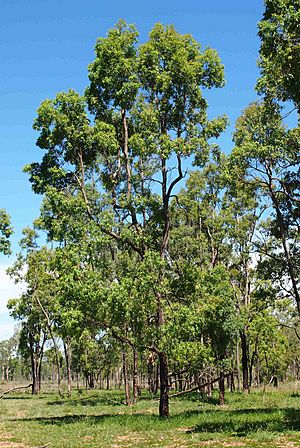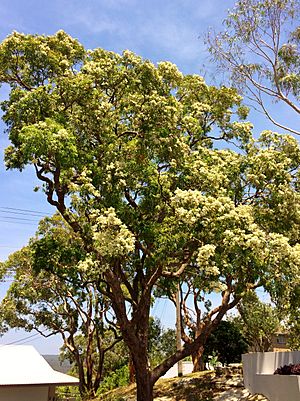Rough-barked apple facts for kids
Quick facts for kids Rough-barked apple |
|
|---|---|
 |
|
| Scientific classification | |
| Genus: |
Angophora
|
| Species: |
floribunda
|
The Angophora floribunda, often called the rough-barked apple, is a common tree found in woodlands and forests in Eastern Australia. It belongs to the Myrtaceae family, which also includes eucalypts. This large tree can grow up to 30 meters (100 feet) tall. It has bark that feels rough and cream-white flowers that bloom during the Australian summer. You can usually find it growing in rich soils near rivers and on floodplains. Sadly, much of the land where it used to grow has been cleared for farming.
Contents
What it Looks Like
The rough-barked apple is a big tree with a wide, spreading shape. It can reach heights of 30 meters (100 feet). Its trunk is often twisted and bent, covered in rough, grey bark.
Like all trees in the Angophora group, its leaves grow in pairs directly opposite each other on the stem. The leaves are dull to shiny green. They are usually 5.5 to 15 centimeters (2.2–6 inches) long and 1 to 5 centimeters (0.4–2 inches) wide. Their shape is like a spear or an egg, and they are attached to the stems by small stalks called petioles, which are 0.6–1.5 centimeters (0.2–0.6 inches) long. Leaves in the drier western areas are often narrower than those near the coast.
Its pretty cream-white flowers appear from November to March.
Sometimes, people might confuse it with another tree called A. subvelutina. However, A. subvelutina has heart-shaped leaves that attach directly to the stem without a stalk.
How it Got its Name
Scientists have a special way of naming plants and animals, which is called taxonomy. The rough-barked apple was first described by a scientist named James Edward Smith in 1797. He called it Metrosideros floribunda. The tree's seeds were collected by John White, a surgeon from New South Wales, in 1794.
By 1804, this tree was growing in Empress Josephine's garden in France. The name floribunda comes from a Latin word meaning "abundant flowers," because it has so many blooms.
Later, in 1830, Robert Sweet gave it its current scientific name, Angophora floribunda. People also call it by other names like apple box, rusty gum, gum myrtle, and Boondah.
Scientists have studied the genes of Angophora trees. They found that Angophora is more closely related to Eucalyptus trees than to Corymbia trees. Because of this, in 2000, a botanist named Ian Brooker suggested the name Eucalyptus florida for this species.
This tree can sometimes mix with another tree called the broad-leaved apple (Angophora subvelutina). They can create a new type of tree that shares features from both parents.
Where it Lives
The rough-barked apple tree grows across eastern Australia. You can find it from central Queensland, through eastern and central New South Wales, and down into eastern Victoria. It prefers to grow in rich, fertile soils, often found on shale or basalt rock.
In open forests, it grows alongside other trees like the swamp she-oak (Casuarina glauca) and various types of eucalypts such as white stringybark (Eucalyptus globoidea) and blackbutt (E. pilularis). In wetter forests, it might grow with the Sydney blue gum (E. saligna). In very dense forests, it can be found near trees like lillypilly (Syzygium smithii) and cheese tree (Glochidion ferdinandi).
How it Lives and Grows
The rough-barked apple is very good at surviving bushfires. It can regrow from special buds hidden under its bark, called epicormic buds. These trees can live for more than a hundred years!
Many animals interact with this tree:
- Flying Foxes: The grey-headed flying fox (Pteropus poliocephalus) and the little red flying fox (P. scapulatus) enjoy eating the flowers.
- Birds: The white-plumed honeyeater (Lichenostomus penicillatus) looks for food among the flowers. The rare regent honeyeater (Xanthomyza phrygia) even uses this tree as a place to build its nest. Female scarlet myzomelas (Myzomela sanguinolenta) have been seen pulling off bark to use for their nests.
- Insects: Several types of jewel beetles, like Curis caloptera and Stigmodera andersoni, visit the flowers. Some of these beetles really prefer the rough-barked apple! Two types of longhorn beetles, Paroplites australis and Agrianome spinicollis, have also been found on these trees.
- Mistletoe: This tree can also be a host for several types of mistletoe plants, such as A. miquelii and D. vitellina. Mistletoe is a plant that grows on other plants.
Growing Your Own
Because the rough-barked apple is such a large tree, it is generally not suitable for small gardens. It needs a lot of space to grow big and strong.
Gallery
- Features of the rough-barked apple (Angophora floribunda)
See also
 In Spanish: Angophora floribunda para niños
In Spanish: Angophora floribunda para niños








